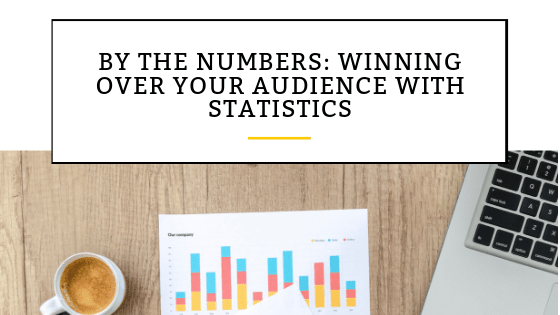By the Numbers: Winning Over Your Audience with Statistics
This is the fourth of seven articles in the “Are You Making This Fatal Mistake with Your Higher Ed Marketing?” series, detailing how to elevate your school’s brand in the minds of your audience using a proven and easy-to-follow framework that puts them at the center of your brand’s story.
When considering examples of effective “reasons to believe” to include for your higher ed marketing strategy, statistics tends to be obvious. It’s through statistics—the “cold hard facts”—that you can often answer some of the most important questions your audience is asking: What is the graduation rate of your programs? How many graduates get jobs, and where? How are my donations being used to support the mission of the school?
Of course, such questions (and many more like these) are perfectly understandable, especially when it comes to one of the biggest investments your customers will make in their lives; an education costs tens of thousands of dollars and will have a lifelong impact. And while there are a constellation of pieces that constitute a convincing and effective brand story, statistics are extremely persuasive in showing your audience that your school can both solve their problems and help them reach their goals.
Similar to testimonials, however, the most challenging aspect of highlighting statistics to your audience is tracking down the right information. No matter how difficult, it’s important to put considerable effort into collecting, organizing, and presenting valuable stats, as this information goes far with today’s increasing public demand for schools to demonstrate their value and worth.
Dig Around for Available Data and Statistics
Collecting data will often mean working closely with other colleagues across campus. For example, you could collaborate with university advancement to find out how many Millennial alumni are donating each month and then use those numbers in a creative way to attract other alumni on social media or email. Or you might reach out to the financial aid office for an up-to-date report on how much aid your school awards so that you present the best information to prospective students and parents in the right places along their buyer journeys. You might already have some great information collected but just need to think through how best to organize and present it in a creative and compelling way. Take time to do a kind of “inventory audit,” going over all of your data to see what could be promoted or more effectively highlighted.
Start Collecting Useful Statistics Now
If you don’t have certain data that you would otherwise find useful, you can begin collecting them today. Even though this effort may not pay off for a couple of years, your work will help ensure a strong marketing story in the future. For example, you could ask your MBA program to start following up on their most recent graduates six months after graduation to see whether and where they are employed. If you have the capacity, offer to help them create an easy-to-complete survey that the business school can send out as an email campaign. What about the school of nursing, education, or engineering? If you start building systems that track the success of your students today, then you’ll have much more to pull from and highlight tomorrow. The key is to start collecting this data as soon as you realize you don’t already have it or aren’t already collecting it.
Leverage Your School’s Statisticians
The truth is that you will not always be able to track down everything you want. It can be hard to get in touch with graduates and busy donors, and you’ll certainly not be able to track down specific information like the average salary of graduates by acquiring a response from each and every alum. Fortunately, there are easy-to-implement statistical models out there to help you establish a large enough population from which you can pull valuable, accurate, and statistically significant data.
In other words, a basic understanding of statistics methodology will allow you to collect meaningful data about an entire population while needing only to talk to a small percentage of your alumni or current students. Several tools online can walk you through this process with relative ease, all without the need to employ an expert statistician (that said, you’re lucky to have an institution with math or sociology departments that most likely have an expert statistician on hand!).
Thinkful, an organization that provides programming and development courses for those looking to get into the tech world, has done a great job of using stats to tell their marketing story. They provide statistics that highlight what one could expect as a return on their investment, including the percentage of grads hired as full-time developers as well as grads’ average reported salary increase. They also provide a detailed breakdown of these two outcomes in impressive report formats. These are exactly the kinds of statistics that give Thinkful’s prospective students the confidence to enroll.
Display Statistics in Eye Catching Graphics
Pepperdine University’s business school (Graziadio) shares convincing stats in a similar way, having devoted space on their website to display outcomes like the percentage of accepted job offers, the highest starting salary, and a breakdown of the industries in which graduates found employment. Another example from higher ed, Kenyon College, offers an easy-to-navigate “Kenyon By The Numbers” section, which features stats that detail its number of tenure-track faculty holding a terminal degree, the percentage of students who graduate in four years, and the number of consecutive years the school has been recognized as a top producer of Fulbright fellows.
Don’t Forget Abound Statistics for Alumni and Donors
While stats like these certainly matter to prospective students, they are also just as important when speaking to your other audiences, such as alumni, donors, or organizational stakeholders (in the case of forging organizational partnerships to increase adult student enrollment). As an institution aspiring to increase financial support, your school is competing against countless other worthwhile charity and non-profit organizations to which your audience could just as easily give their money.
Powerfully communicating with their audience, Invisible Children’s website highlights key stats in the same way that any other company would to instill confidence in their prospective supporters. They appeal to donors by including the number of bills signed into law with the help of their efforts as well as how many tens of millions of dollars they have gotten the U.S. Government to spend on life-saving programs in Central African Communities.
Turning back to higher ed, the University of Michigan in Ann Arbor leverages donors by highlighting the success of their “Giving Blueday” with a breakdown of how much money specific programs and initiatives within their various schools and departments received. Rather than state that the university raised money for the institution as a whole, the detailed breakdown precisely lays out where donors’ money is going. When potential donors know how money is used, they will be much more confident that their contributions will be applied in the way they want them to be.
Lastly, using statistics for your higher ed marketing adds a level of professionalism and respect to your school. It conveys to your audience that you take both their concerns and questions seriously and that they deserve to have accurate data and information to help them make the decision that’s best for them.
Steps to Consider:
Audit your content to identify the areas in which you are using stats. Are there areas in your marketing that could benefit from a piece of data? Make sure you do this for each major audience—you may, for example, have great stats for donors but lack compelling stats for adult degree completion students (remember that marketing to adult students will look very different than marketing to traditional ones).
Are the stats you’re highlighting up to date and convincing? Might there be a more interesting and compelling way to represent them with your design? Stats from ten years ago aren’t going to be nearly as effective as stats from last year.
If you aren’t already collecting information that would be valuable, how can you start doing so? Try to identity who you need to work with in order to put into place a helpful system of data collection.
If you can’t track down certain data, are there other ways to convey something similar? For example, if you can’t find out the average salary of graduating MBA students, can you at least find out how many graduating MBA students get jobs within six months of graduation? It’s worth thinking creatively about what you can highlight even if what you want to highlight isn’t available.





